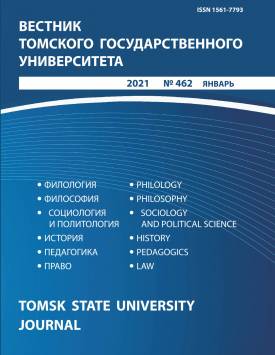Stylistic and Semantic Features of Epitaphs (Based on Texts of Provincial Cemeteries in Perm Krai). Part I
The first part of the article describes the stylistic features of poetic epitaphs recorded during field surveys of provincial cemeteries in Perm Krai in 2019. These texts have not only historical and source-study, but also cultural value. The establishment of the features of the broad epitaph heritage in a particular historical period leads to an understanding of the worldview of representatives of everyday life of the given time. When classifying the material, the author took into account the nature of authorship and the genre function. On these grounds, the collected texts are divided into four groups. Group 1 is folklore texts for which the epitaph function is initial. These are epitaphs generated in the folk environment, they are characterized by anonymity, a characteristic set of topics, variability, a high degree of formulaicity and a typified subject. They are broadcast not only in real conditions, but also on the Internet. Group 2 is folklore texts for which the epitaph function is secondary. Such texts are a rare occurrence in cemetery poetry associated with subcultural folklore. Group 3 is authorial texts for which the epitaph function is initial. This group is organized by anonymous works of amateur nature. Fixed in a single copy, they do not find variants either in cemeteries or on the Internet. The stylistic differences between naive epitaphs and folk epitaphs are reduced to the individualization of the dead through their lifetime qualities, as well as the manifestation of the author's poetic talent. Group 4 is authorial texts for which the epitaph function is secondary. According to the genre of the source, these works belong to poems, novels, dramas, literary epitaphs, aphorisms, and songs. Poetic quotations in the function of epitaphs can be transmitted verbatim or be reworked in accordance with new content and stylistic tasks. In addition to these categories, the studied material also reveals as a transitional phenomenon, when a popular text loses its connection with the author and functions as a folk text. The basis for identifying transient phenomena is provided by Internet statistics. In the final section of the first part, conclusions are drawn about 1) the prevalence of epitaph texts in the cemetery space of the province; 2) the correlation of the author's classification with previous works on the style of epitaphs; 3) the thematic features of cemetery poetry; 4) the presence of regional specificity in the presented set of texts.
Keywords
linguoculturology, urban culture, death, epitaph, written folklore, naive poetryAuthors
| Name | Organization | |
| Panteleeva Liliya M. | Solikamsk State Pedagogical Institute (Branch) of Perm State University | liliya_pant@mail.ru |
References

Stylistic and Semantic Features of Epitaphs (Based on Texts of Provincial Cemeteries in Perm Krai). Part I | Vestnik Tomskogo gosudarstvennogo universiteta – Tomsk State University Journal. 2021. № 462. DOI: 10.17223/15617793/462/5
